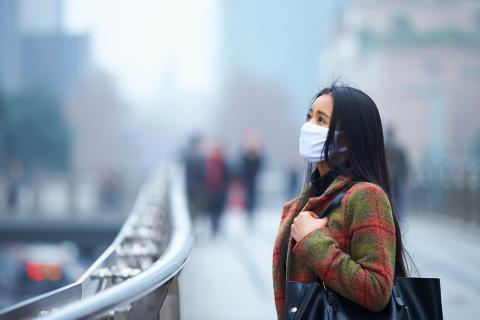
Covid-19. Air pollution as a probable risk factor
Studies suggest that Covid-19 is more lethal in heavily polluted areas. Isabella Annesi-Maesano explains.
Isabella Annesi-Maesano, head of the Epidemiology of Allergic and Respiratory Diseases team at the Institut Pierre-Louis d’épidémiologie et santé publique, sheds light on the links between air pollution and Covid-19.
Does air pollution promote the spread of the SARS-CoV-2 virus responsible for Covid-19
Isabella Annesi-Maesano1 : From the very outset of the pandemic, the scientific community has observed that the first epidemic outbreaks in China, Lombardy, Iran and elsewhere, occurred in highly polluted areas. Based on the first available data, several research teams began to investigate the link between air pollution and Covid-19, particularly in China, Italy and the United Kingdom. Despite the use of different methodologies, their studies confirm the existence of a statistically significant association between the number of Covid-19 cases, their severity in terms of deaths and the level of air pollution.
These results support what we already know in the case of other respiratory viruses, such as influenza, SARS-CoV-1, responsible for the outbreak of Severe Acute Respiratory Syndrome (SARS) from 2002 to 2004, or the syncytial virus, responsible for bronchiolitis in children: when the virus is present, air pollution increases the number of infections.
How is this virus transmitted through the air?
I. A.-M. : SARS-CoV-2 is primarily transmitted by droplets or by contact with a contaminated surface. But studies show that the virus, which is 130 nanometres in size and weighs only a few dozen fentograms (10-15), is also present in airborne form.
The air can spread this virus in two ways. Once emitted by a sick person, it can graft onto breathable 10-micron particles, capable of carrying viruses, pollens, spores and other elements. This phenomenon has been observed using an electron microscope in the case of other respiratory viruses. The virus can also be carried by ultrafine particles (less than 0.1 micron) within what we call secondary aerosols. These aerosols are a mixture of liquid and solid particles generated by the transformation of gases present in the atmosphere and primary particles2 directly emitted into the air. Within these aerosols, the virus attaches to the other particles.
While researchers have recently found SARS-CoV-2 in these aerosols, which are commonly found in air pollution, the question remains as to whether the virus found there is active and whether it can infect people. While awaiting the results of ongoing studies, the precautionary principle applies. In particular, great care must be taken with ventilation and air conditioning indoors, especially in hospitals, as there is a potential danger.
How does air pollution make us more vulnerable to Covid-19?
I. A.-M. : While air pollution can promote the spread of the virus, it is now well established that it is also a risk factor for Covid-19. On the one hand, it is an irritant and damages the mucous membranes of the nose and throat, which become more permeable, making it easier for the virus to enter the body.
On the other hand, fine particles, by reaching the lungs, but also the heart, kidneys, brain, blood vessels, and other organs, cause systemic inflammation of the body. This inflammation, weakens the immune system and causes respiratory, cardiovascular, neurological and metabolic problems that are the cause of chronic diseases (such as chronic obstructive pulmonary disease, diabetes and obesity). However, we have observed that Covid-19 patients who are most at risk of developing serious forms of the disease present precisely these pathologies as co-morbidities.
Many of these conditions are treated with anti-inflammatory and cortisone type drugs, which can make the infection worse.
Are masks effective in preventing contamination through air pollution?
I. A.-M. : If everyone wears a mask, this prevents the emission of sputum and aerosols into the air and thus the transmission of the virus. On the other hand, to protect oneself from pollutants in the air, one would need very sophisticated and expensive masks. However, at the beginning of the epidemic, France did not even have enough masks to equip all the medical staff in hospitals.
Has there been a positive effect related to the reduction of pollution during lockdown?
I. A.-M. : According to the air quality monitoring site, Airparif, pollution levels dropped considerably during lockdown. Yet we know that in France, at least 48,000 deaths per year are due to air pollution. The reduction in pollution during lockdown has therefore certainly contributed to reducing the number of deaths.
However, it is worth remembering that pollution was not zero during these two months, due to deliveries, transport, the spreading of fertilisers and pesticides, ozone, cross-border pollution, etc. There were even peaks.
1 Pierre-Louis Institute of Epidemiology and Public Health (IPLESP, Sorbonne University/Inserm)
2 For example, mineral particles resulting from soil erosion, sand, sea spray, volcanic ash, etc., may be present. In urban areas, soot from domestic heating, particles emitted directly from fuel combustion, or from the re-suspension of roadway deposits by traffic can be found.
